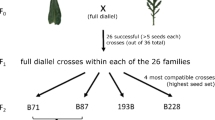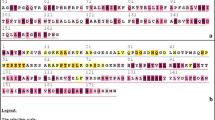Abstract
A survey of allelic variation at the Aat-3 locus in Senecio squalidus and S. vulgaris revealed that the Aat-3c allele, which was present at high frequency in British populations of S. squalidus, was also common in British radiate groundsel (S. vulgaris var. hibernicus) but was rare among individuals of the non-radiate groundsel (S. vulgaris var. vulgaris) which co-occurred with var. hibernicus and was absent from British, Irish and mainland European populations monomorphic for var. vulgaris. This evidence is taken as confirmation of an introgressive origin of S. vulgaris var. hibernicus across a chromosome barrier following hybridization between S. vulgaris var. vulgaris (2n = 40) and radiate S. squalidus (2n = 20) and backcrossing to S. vulgaris var. vulgaris. Genetic analysis showed that the Aat-3 locus, which is duplicated in S. vulgaris is not linked to the ray floret locus controlling capitulum type. It is suggested that the close association between the Aat-3c allele and the radiate allele in populations of S. vulgaris polymorphic for capitulum type may be maintained by selection favouring a co-adapted complex of genes introgressed from S. squalidus, although alternative explanations are not ruled out. The introgression of the Aat-3c allele and associated genetic material from S. squalidus into S. vulgaris is likely to have enhanced the level of genetic variation present within S. vulgaris and may have been a factor that has favoured the spread of S. vulgaris var. hibernicus in Britain following its origin last century.
Similar content being viewed by others
Article PDF
References
Abbott, R J. 1986. Life history variation associated with the polymorphism for capitulum type and outcrossing rate in S. vulgaris. Heredity, 56, 381–392.
Abbott, R J, and Horrill, J C. 1991. Survivorship and fecundity of the radiate and non-radiate morphs of groundsel, Senecio vulgaris L., raised in pure stand and mixture. J Evol Biol, 4, 241–257.
Abbott, R J, and Irwin, J A. 1988. Pollinator movements and the polymorphism for outcrossing rate in Groundsel, Senecio vulgaris L. Heredity, 60, 295–298.
Alexander, J C M. 1979. The Mediterranean species of Senecio sections Senecio and Delphinifolius. Notes Roy Bot Gard Edin, 27, 387–428.
Allard, R W. 1956. Formulas and tables to facilitate the calculation of recombination values in heredity. Hilgardia, 24, 235–278.
Anderson, E. 1949. Introgressive Hybridization. John Wiley, New York.
Arnold, M L, Hamrick, J L, and Bennett, B D. 1990. Allozyme variation in Louisiana irises: a test for introgression and hybrid speciation. Heredity, 65, 297–306.
Ashton, P A. 1990. Multiple Origins of Senecio cambrensis Rosser, and Related Evolutionary Studies in British Senecio. Unpublished Ph.D. Thesis, University of St Andrews.
Bloom, W L. 1976. Multivariate analysis of the introgressive replacement of Clarkia nitens by Clarkia speciosa polyantha. Evolution, 30, 412–424.
Brettell, R I S, and Leslie, A C. 1978. Senecio squalidus L. × S. vulgaris L. in Cambridgeshire. Watsonia, 12, 155.
Briggs, D, and Walters, S M. 1984. Plant Variation and Evolution. 2nd edn, Cambridge University Press, Cambridge.
Charlesworth, D, and Charlesworth, B. 1987. Inbreeding depression and its evolutionary consequences. Ann Rev Ecol Syst, 18, 237–268.
Crisp, P C. 1972. Cytotaxonomic studies in the section Annui of Senecio. Unpublished Ph.D. Thesis, University of London.
Davis, J L. 1985. Introgression in Central American Phytolacca (Phytolaccaceae). Am J Bot, 72, 1944–1953.
Druce, G C. 1927. The Flora of Oxfordshire. 2nd edn, Clarendon Press, Oxford.
Ellstrand, N C, Lee, J H, Keeley, J E, and Keeley, S C. 1987. Ecological isolation and introgression: biochemical confirmation of introgression in an Arctostaphylos (Ericaceae) population. Acta Oecol, 8, 299–308.
Fisher, R A. 1941. Average excess and average effect of a gene substitution. Ann Eugen, 11, 53–63.
Gibbs, P E, Milne, C, and Vargas Carrillo, M. 1975. Correlation between the breeding system and recombination index in five species of Senecio. New Phytol, 75, 619–626.
Gottlieb, L D. 1973. Genetic control of glutamate oxaloace-tate transaminase isozymes in the diploid plant Stephanomeria exigua and its allopolyploid derivatives. Biochem Genet, 9, 97–107.
Grant, V. 1950. Genetic and taxonomic studies in Gilia. Aliso, 2, 239–316.
Grant, V. 1981. Plant Speciation. 2nd edn, Columbia University Press, New York.
Hamrick, J L, and Godt, M J W. 1990. Allozyme diversity in plant species, pp.43–63. In: Brown, A. H. D., Clegg, M. T., Kahler, A. L. and Weir, B. S. (eds) Plant Population Genetics, Breeding, and Genetic Resources. Sinauer, MA, pp. 43–63.
Harper, J L, and Wood, W A. 1957. Biological Flora of the British Isles. Senecio jacobaea L. J Ecol, 45, 617–637.
Hartl, D L. 1981. A Primer of Population Genetics. Sinauer, MA.
Heiser, C B. 1949. Study in the evolution of the sunflower species Helianthus annuus and H. bolanderi. Univ Calif Publ Bot, 23, 157–196.
Heiser, C B. 1951. Hybridization in the annual sunflowers Helianthus annuus × H. debilis var. cucumerifolius. Evolution, 5, 42–51.
Heiser, C B. 1973. Introgression re-examined. Bot Rev, 39, 347–366.
Hull, P. 1974. Self-fertilisation and the distribution of the radiate form of Senecio vulgaris L. in Central Scotland. Watsonia, 10, 69–75.
Ingram, R. 1977. Synthesis of the hybrid Senecio squalidus L. × S. vulgaris L. F. radiatus Hegi. Heredity, 39, 171–173.
Ingram, R. 1978. The genomic relationship of Senecio squalidus L. and S. vulgaris L. and the significance of genomic balance in their hybrid, S. × baxteri Druce. Heredity, 40, 459–462.
Ingram, R, and Taylor, L. 1982. The genetic control of a non-radiate condition in Senecio squalidus L. and some observations on the role of ray florets in the Compositae. New Phytol, 91, 749–756.
Ingram, R, Weir, J A, and Abbott, R J. 1980. New evidence concerning the origin of inland radiate groundsel Senecio vulgaris L. var. hibernicus Syme. New Phytol, 84, 543–546.
Levin, D A. 1963. Natural hybridization between Phlox maculata and P. glaberrima and its evolutionary significance. Am J Bot, 50, 714–719.
Levin, D A. 1975. Interspecific hybridization, heterozygosity and gene exchange in Phlox. Evolution, 29, 37–51.
Lloyd, D G. 1979. Some reproductive factors affecting the selection of self-fertilization in plants. Am Nat, 113, 67–79.
Marshall, D F, and Abbott, R J. 1980. On the frequency of introgression of the radiate (Tr) allele from Senecio squalidus L. into Senecio vulgaris L. Heredity, 45, 133–135.
Marshall, D F, and Abbott, R J. 1982. Polymorphism for outcrossing frequency at the ray floret locus in Senecio vulgaris L. I. Evidence. Heredity, 48, 227–235.
Marshall, D F, and Abbott, R J. 1984a. Polymorphism for outcrossing frequency at the ray floret locus in Senecio vulgaris L. II. Confirmation. Heredity, 52, 331–336.
Marshall, D F, and Abbott, R J. 1984b. Polymorphism for outcrossing frequency at the ray floret locus in Senecio vulgaris L. III. Causes. Heredity, 53, 145–149.
Maynard Smith, J. 1978. The ecology of sex. In: J. R. Krebs and N. B. Davies (eds) Behavioural Ecology An Evolutionary Approach. Blackwell Scientific Publications Ltd, Oxford, pp. 159–179.
Monaghan, J, and Hull, P. 1976. Differences in vegetative characteristics among four populations of Senecio vulgaris L. possibly due to interspecific hybridization. Ann Bot, 40, 125–128.
Nei, M. 1973. Analysis of gene diversity in subdivided populations. Proc Nat Acad Sci USA, 70, 3321–3323.
Olivieri, I. 1985. Comparative electrophoretic studies of Carduus pynochephalus L., C. tenuiflorus Curt. (Asteraceae) and their hybrids. Am J Bot, 72, 715–718.
Ornduff, R. 1964. Evoltionary pathways of the Senecio lautus alliance in New Zealand and Australia. Evolution, 18, 349–360.
Ornduff, R. 1967. Hybridization and regional variation in Pacific Northwestern Impatiens. (Balsaminaceae). Brittonia, 19, 122–128.
Rieseberg, L H, Beckstrom-Sternberg, S, and Doan, K. 1990. Helianthus annuus ssp. texanus has chloroplast DNA and nuclear ribosomal RNA genes of Helianthus debilis ssp. cucumerifolius. Proc Natl Acad Sci USA, 87, 593–597.
Rieseberg, L H, Soltis, D E, and Palmer, J D. 1988. A molecular re-examination of introgression between Helainthus annuus and H. bolanderi (Compositae). Evolution, 42, 227–238.
Rollo, C D, MacFarlane, J D, and Smith, B S. 1985. Electrophoretic and allometric variation in burdock (Arctium spp): hybridization and its ecological implications. Can J Bot, 63, 1255–1261.
Stace, C A. 1977. The origin of radiate Senecio vulgaris L. Heredity, 39, 383–388.
Stace, C A. 1987. Hybridization and the Plant Species. In: Urbanska, K. M. (ed.) Differentiation Patterns in Higher Plants. Academic Press, London, pp. 115–127.
Stebbins, G L. 1959. The role of hybridization in evolution. Proc Am Phil Soc, 103, 231–251.
Stebbins, G L. 1969. The significance of hybridization for plant taxonomy and evolution. Taxon, 18, 26–35.
Soltis, D E, and Soltis, P S. 1986. Intergeneric hybridization between Conimitella williamsii and Mitella stauropetala (Saxifragaceae). Syst Bot, 11, 293–297.
Suiter, K A, Wendel, J F, and Case, J S. 1983. LINKAGE-1: a PASCAL computer program for the detection and analysis of genetic linkage. J Hered, 74, 203–204.
Syme, J T B. 1875. Senecio vulgaris L. var. hibernica mihi. Bolt Exch Club, Rep Curators, 1872–74, 27–28.
Taylor, L. 1984. The potential for introgression in a British polyploid complex. Unpublished Ph.D. Thesis, University of St. Andrews.
Trow, A H. 1912. On the inheritance of certain characters in the Common Groundsel, Senecio vulgaris L., and its segregates. J Genet, 2, 239–276.
Weeden, N F, and Wendel, J F. 1989. Genetics of plant isozymes. In: Soltis, D. E. and Soltis, P. S. (eds) Isozymes in Plant Biology. Chapman and Hall, London, pp. 46–72.
Wright, S. 1951. The genetical structure of populations. Ann Eugen, 15, 323–354.
Author information
Authors and Affiliations
Rights and permissions
About this article
Cite this article
Abbott, R., Ashton, P. & Forbes, D. Introgressive origin of the radiate groundsel, Senecio vulgaris L. var. hibernicus Syme: Aat-3 evidence. Heredity 68, 425–435 (1992). https://doi.org/10.1038/hdy.1992.62
Received:
Issue date:
DOI: https://doi.org/10.1038/hdy.1992.62
Keywords
This article is cited by
-
Introgressive replacement of natives by invading Arion pest slugs
Scientific Reports (2017)
-
CYCLOIDEA 2 Clade Genes: Key Players in the Control of Floral Symmetry, Inflorescence Architecture, and Reproductive Organ Development
Plant Molecular Biology Reporter (2017)
-
Multiple hybridization events, polyploidy and low postmating isolation entangle the evolution of neotropical species of Epidendrum (Orchidaceae)
BMC Evolutionary Biology (2014)
-
Recent hybrid origin and invasion of the British Isles by a self-incompatible species, Oxford ragwort (Senecio squalidus L., Asteraceae)
Biological Invasions (2009)
-
Patterns of MADS-box gene expression mark flower-type development in Gerbera hybrida(Asteraceae)
BMC Plant Biology (2006)



